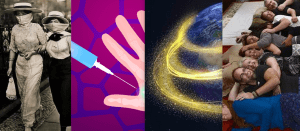Dear Earthlings:
The EcoSex course at U Conn is in process. It’s a great experience. We are reading amazing books. Thinking out of the box and across disciplines. Students are sending their responses in, with discussion questions. In class, we connect the dots: a holograph of what we’ve read together, the “required readings.” Multiple perspectives and good synergy. Here, we offer a glimpse. Lynn Margulis and Dorion Sagan’s Mystery Dance was one of two theory-of-science books. We got four responses: from John, Alissa, Rhiann, Adam, and Michael.
Here’s Michael‘s take:
Response to Lynn Margulis and Dorion Sagan’s Mystery Dance: On the Evolution of Human Sexuality
 An issue that arises for me when reading Mystery Dance and the other books assigned by Lynn Marguiles is that I feel I at times focus too much on the trees and miss the broader forest of her points. Having said that, I really enjoyed this book as it presented a nice synthesis of philosophy, zoological evolution and microbiology all of which I like. I did however have some issues with some of the evidence she presents and manner in which she argues for her points. On page 27 when she talks about the idea of a sexual bacterial ‘super-organism’, I find this idea very intriguing because research that has occurred in the 20 years since this book was published has only added evidence supporting the notion of cooperation and altruism between various certain bacterial species that goes beyond her basic examples of their ability to recycle each-other’s metabolites for their own use. I think this if anything is how I view the idea of Gaia, and while the DNA exchanges that occur are the prototype upon which sexual reproduction evolved I think Marguiles should also have mentioned the antagonistic relationship that these organisms share as well. While cooperation does occur, many of these bacteria are also at war with each-other, particularly if they share the same metabolites so there is a degree of antagonism that occurs as well. I think this should have mentioned because it paints a fuller picture of this ‘super-organism’ and because it provides an interesting analogy to the antagonistic war of the sexes in the reproduction of various animals that she documents subsequently. I found she often engaged in the same kind of chauvinistic use of biological evidence that she addressed as what was wrong with how Social Darwinists and others utilized biology in the past. This occurs problematically, in my mind at least, throughout the book, but is most egregious in her discussion of the rise of the patriarchy and phallocracy on page 54 as a consequence of the evolution of Homo sapiens. Earlier she references the descent of Homo erectus as the beginning of our abandonment of chimpanzee-like promiscuity towards monogamy and the protection of females due to the physical power of men which she again references here via her examples of early hunting by males and gathering by females. Based on my experiences taking some anthropology classes on early man and reading the book Born to Run, I would disagree with her use of evolutionary biology to place the origins of the patriarchy at this point in humanity’s existence. Homo erectus differentiated himself from the last common ancestor we share with chimpanzees and other apes because of his ability to run. This is the primary method humanity used throughout the bulk of its history over the last 50,000 years to procure food. There is a greater discrepancy between the sizes of male and female apes like gorillas than between male and female early humans because the physical size of males was actually counterproductive for running and males began shrinking via the selective pressure of these long distance hunts. Born to Run also presents a myriad of evidence of the fact that as you increase the distance of an endurance run the difference between male and female competitors disappears. Ultra-marathoning of the kind ancient tribes utilized to hunt created an equal playing field between the sexes’ roles in survival unlike any seen prior to that point in primates. Similarly, the archaeological evidence of shamanistic rituals I encountered within anthropology also painted a picture of shared shaman roles between the sexes, if not a slant towards female shamans. I’d instead argue that the rise of the patriarchy began much later in human history, only at the dawn of organized agriculture and with it organized religion, within the last 10,000 years, where the larger physical strength of males would present an advantage that they did not necessarily have earlier in hunting by running animals to death.
An issue that arises for me when reading Mystery Dance and the other books assigned by Lynn Marguiles is that I feel I at times focus too much on the trees and miss the broader forest of her points. Having said that, I really enjoyed this book as it presented a nice synthesis of philosophy, zoological evolution and microbiology all of which I like. I did however have some issues with some of the evidence she presents and manner in which she argues for her points. On page 27 when she talks about the idea of a sexual bacterial ‘super-organism’, I find this idea very intriguing because research that has occurred in the 20 years since this book was published has only added evidence supporting the notion of cooperation and altruism between various certain bacterial species that goes beyond her basic examples of their ability to recycle each-other’s metabolites for their own use. I think this if anything is how I view the idea of Gaia, and while the DNA exchanges that occur are the prototype upon which sexual reproduction evolved I think Marguiles should also have mentioned the antagonistic relationship that these organisms share as well. While cooperation does occur, many of these bacteria are also at war with each-other, particularly if they share the same metabolites so there is a degree of antagonism that occurs as well. I think this should have mentioned because it paints a fuller picture of this ‘super-organism’ and because it provides an interesting analogy to the antagonistic war of the sexes in the reproduction of various animals that she documents subsequently. I found she often engaged in the same kind of chauvinistic use of biological evidence that she addressed as what was wrong with how Social Darwinists and others utilized biology in the past. This occurs problematically, in my mind at least, throughout the book, but is most egregious in her discussion of the rise of the patriarchy and phallocracy on page 54 as a consequence of the evolution of Homo sapiens. Earlier she references the descent of Homo erectus as the beginning of our abandonment of chimpanzee-like promiscuity towards monogamy and the protection of females due to the physical power of men which she again references here via her examples of early hunting by males and gathering by females. Based on my experiences taking some anthropology classes on early man and reading the book Born to Run, I would disagree with her use of evolutionary biology to place the origins of the patriarchy at this point in humanity’s existence. Homo erectus differentiated himself from the last common ancestor we share with chimpanzees and other apes because of his ability to run. This is the primary method humanity used throughout the bulk of its history over the last 50,000 years to procure food. There is a greater discrepancy between the sizes of male and female apes like gorillas than between male and female early humans because the physical size of males was actually counterproductive for running and males began shrinking via the selective pressure of these long distance hunts. Born to Run also presents a myriad of evidence of the fact that as you increase the distance of an endurance run the difference between male and female competitors disappears. Ultra-marathoning of the kind ancient tribes utilized to hunt created an equal playing field between the sexes’ roles in survival unlike any seen prior to that point in primates. Similarly, the archaeological evidence of shamanistic rituals I encountered within anthropology also painted a picture of shared shaman roles between the sexes, if not a slant towards female shamans. I’d instead argue that the rise of the patriarchy began much later in human history, only at the dawn of organized agriculture and with it organized religion, within the last 10,000 years, where the larger physical strength of males would present an advantage that they did not necessarily have earlier in hunting by running animals to death.
Question: At a point in the first Chapter, Marguiles uses her arguments about ritualistic violence inherent in males and sperm competition to offer an explanation for gang rapes. Do you agree with her perspective or not? Why?
Michael Maranets
Published with permission
WGSS 3998 – Ecosexuality and the Ecology of Love
Prof. Serena Anderlini-D’Onofrio
U Conn, Storrs, Spring 2013
Dear Earthlings:
Let “nature” be your teacher in the arts of love. Education is the heart of democracy, education to love. Come back for more wonders: Students Responses to appear every Tuesday. Book Reports to be scheduled soon, every other Thursday. Check out our summer offerings: Ecosexuality in Portland, OR, July 17-21. Info and Registration here!
Namaste,
Serena Anderlini-D’Onofrio, PhD
Gilf Gaia Extraordinaire
University of Puerto Rico, Mayaguez
Follow us in the social media
Poly Planet GAIA Blog:
http://polyplanet.blogspot.
http://polyplanet.blogspot.
Website: www.serenagaia.com
Be Appraised of Ecosex Community Project PostaHouse
Become a Fan: www.facebook.com/GaiaBlessings
Author’s Page/Lists all books:
YouTube Uploaded Videos: http://www.youtube.com/
http://polyplanet.blogspot.com












